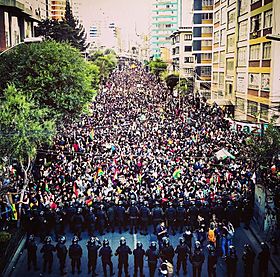2019 Bolivian protests facts for kids
Quick facts for kids 2019 Bolivian protests |
|||
|---|---|---|---|

People protesting in La Paz
|
|||
| Date | Before Morales resignation 21 October – 10 November 2019 After Morales resignation 11–21 November 2019 |
||
| Location | |||
| Methods | Protests, rioting, civil resistance, unrest, strikes | ||
| Resulted in |
|
||
| Parties to the civil conflict | |||
|
|
|||
| Lead figures | |||
|
|||
| Casualties | |||
| Death(s) | 33 (as of 27 November 2019) | ||
| Injuries | 804 (as of 27 November 2019) | ||
| Arrested | 1511 (as of 27 November 2019) | ||
From October 21 to late November 2019, many protests and marches happened in Bolivia. People were upset about the results of the 2019 general election held on October 20. Many believed the election results were not fair.
After November 11, 2019, supporters of the old government also started protesting. This happened after Jeanine Áñez became the temporary president of Bolivia. The claims of unfairness began when the first count of votes was stopped. The current president, Evo Morales, was not ahead by enough votes (10%) to win without a second round of voting.
Contents
What Caused the Protests?
The main reason for the protests was the 2019 Bolivian general election. People were worried that the election results were not correct. The vote count was stopped for a day, which made many people suspicious.
Concerns About the Vote Count
When the vote count restarted, President Morales's lead had grown a lot. This made many people think that something was wrong. They believed there might have been cheating in the election.
The Idea of a Runoff Election
In Bolivia, if no candidate wins more than 50% of the votes, or is not ahead by at least 10% more than the second-place candidate, there must be a second round of voting. This is called a runoff. Many people felt that President Morales should have had to go through a runoff election.
Who Was Involved in the Protests?
The protests involved different groups of people with different ideas.
Supporters of Evo Morales
- These were people who supported the current president, Evo Morales.
- They included members of his political party, the Movement for Socialism (MAS).
- The Bolivian Armed Forces and National Police supported Morales at first.
Opponents of Evo Morales
- These were people who did not agree with President Morales.
- They included groups like the Civic Community coalition.
- After November 10, the Bolivian National Police and Armed Forces started supporting the anti-Morales side.
What Happened During the Protests?
The protests involved many different actions by people.
Peaceful Marches and Rallies
- Many people gathered in cities to march and show their disagreement.
- They held signs and chanted slogans.
Strikes and Civil Resistance
- Some people went on strike, meaning they stopped working to show their protest.
- This also included acts of civil resistance, where people peacefully refused to follow certain rules.
Riots and Unrest
- Unfortunately, some protests turned violent.
- There were riots and general unrest in some areas.
The Outcome of the Protests
The protests led to big changes in Bolivia's government.
Evo Morales Resigns
- On November 10, 2019, President Evo Morales resigned from his position.
- He said he was doing this to help bring peace to the country.
Jeanine Áñez Becomes Acting President
- After Morales resigned, Jeanine Áñez became the temporary president of Bolivia.
- She announced that new elections would be held in October 2020.
Impact on People
- Sadly, the protests resulted in some people being hurt or arrested.
- As of November 27, 2019, 33 people had died, 804 were injured, and 1511 were arrested.
See also
 In Spanish: Protestas en Bolivia de 2019 para niños
In Spanish: Protestas en Bolivia de 2019 para niños
Images for kids


